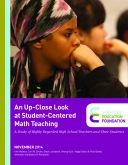An Up-Close Look at Student-Centered Math Teaching
Today, far too many students see mathematics as a subject to be endured, rather than a subject of real-world importance and personal value. That doesn’t have to be the case. When teachers use student-centered techniques to engage students in more active and authentic ways, they can transform math classrooms into lively learning environments in which students take charge of their own learning, collaborate with others, persist in solving complex problems, and make meaningful connections to the world around them.
 While a growing body of research supports many of the principles of student-centered instruction, there is still a great deal to learn about how such approaches enhance student learning in mathematics. Recent calls for strengthening the STEM workforce and for more rigorous K-12 standards via the Common Core State Standards have placed increased emphasis on developing higher-order thinking and problem-solving skills in high school mathematics, heightening the need for more information about how teachers can effectively engage students with math content.
While a growing body of research supports many of the principles of student-centered instruction, there is still a great deal to learn about how such approaches enhance student learning in mathematics. Recent calls for strengthening the STEM workforce and for more rigorous K-12 standards via the Common Core State Standards have placed increased emphasis on developing higher-order thinking and problem-solving skills in high school mathematics, heightening the need for more information about how teachers can effectively engage students with math content.
With support from the Nellie Mae Education Foundation, AIR conducted a study of highly regarded high school math teachers to expand the research base in two important ways. First, the team used a case study approach to provide rich descriptions of how the approach plays out in several classrooms; second, the researchers looked across a larger sample of classrooms to determine the effects of varying degrees of student-centeredness on students’ engagement with learning and their problem-solving skills.
Key Findings
Student Outcomes
- Students in math classrooms led by highly regarded teachers feel very positively about their teacher and the class. However, students with highly regarded teachers who implement more student-centered approaches to math instruction report that they find the content more interesting and meaningful.
- Students in more student-centered math classrooms report being more engaged in how much they are learning and how interested they are in the material, compared to students in less student-centered classrooms.
- Students in more student-centered math classrooms showed higher growth on a test of problem-solving skills than students in less student-centered classrooms.
Classroom Approaches
- Nearly all highly regarded teachers employ student-centered practices at times.
- Student-centered math instruction allows for strong student contribution, encourages active student exploration, uses problems that require students to think critically and communicate their thinking, and asks students to explain the “why” of their answers.
The Larger School Context
- Teachers who implement student-centered approaches more regularly worked in schools that focused on preparing students for a variety of future pathways.
- Classrooms that emphasized exploratory learning were situated in schools where teachers have both flexibility in lesson design and access to needed materials
